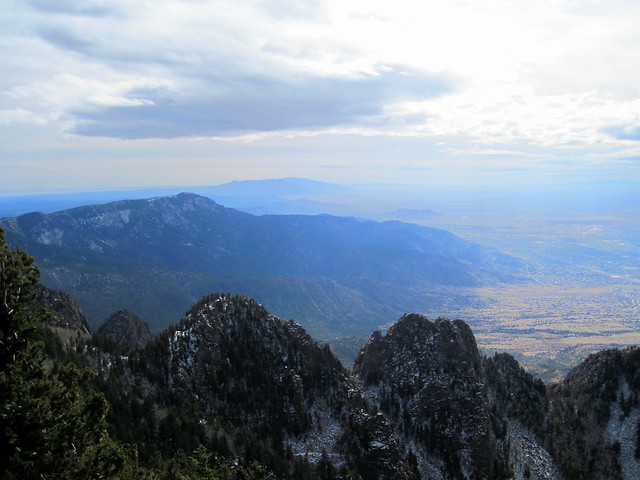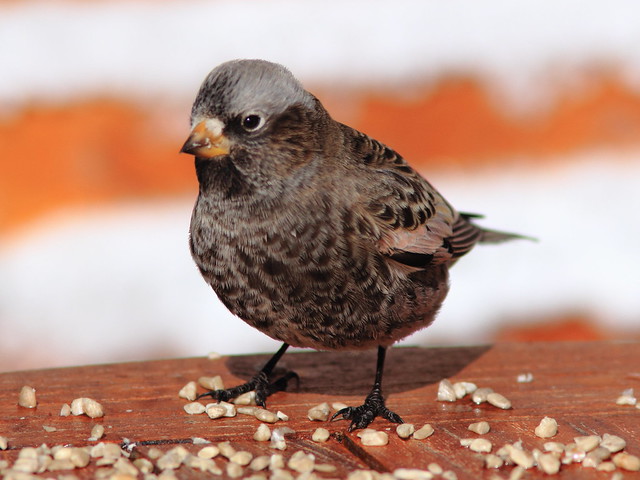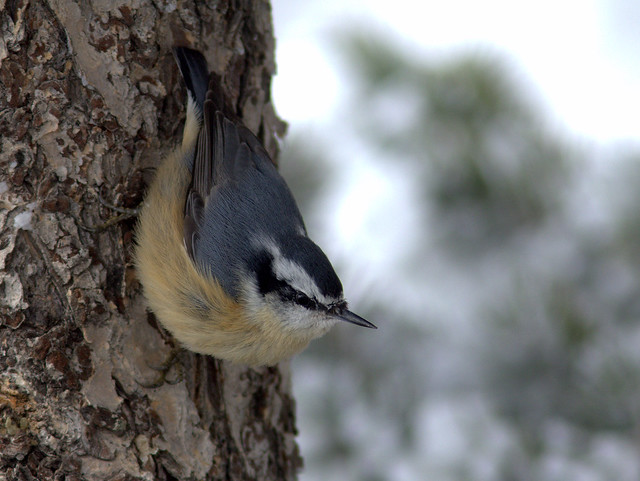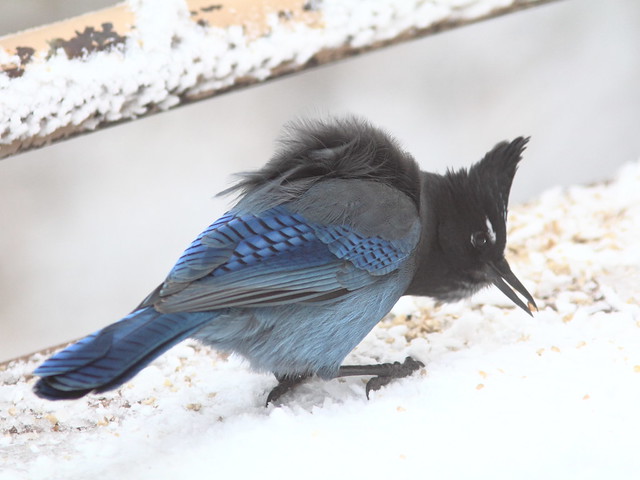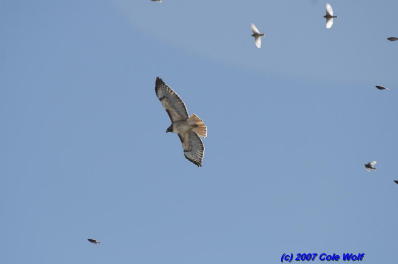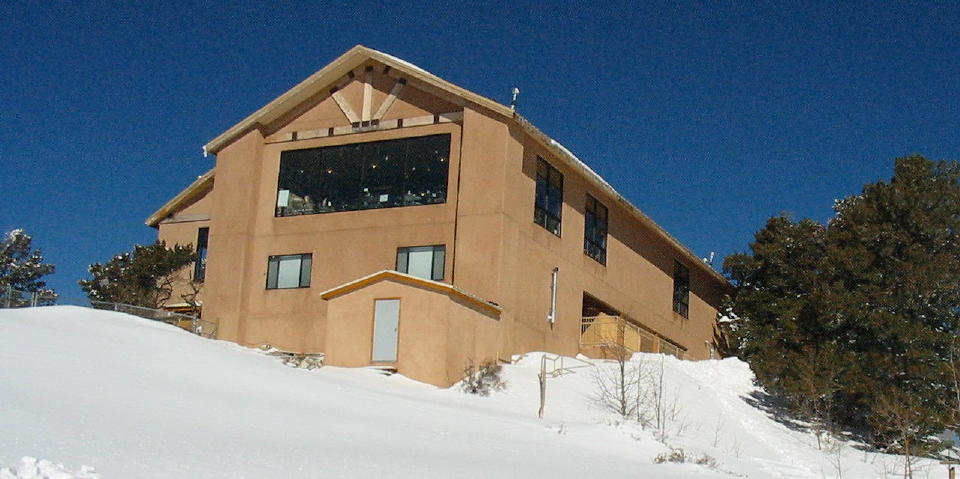Posted by: Ken @ 1:47 pm
In a random but unknowing act of kindness, the construction worker tossed his half-eaten sandwich on a snowbank along the road, and returned to his job. A small flock of dark-feathered birds flew down and shared the treat…
But, wait. I’m getting ahead of this story. I might have started with “It was a dark and snowy morning when we drove to the top of the world…” Instead, let’s begin by recollecting our repeated futile attempts to find rosy-finches on the top of Sandia Crest, 10,678 feet above sea level, near our previous home in New Mexico. Several times since moving there in 1993, Mary Lou and I would follow up on reports of rosy-finch sightings on or near the Crest, only to be disappointed.
“It was a clear and cold morning…” in early December, 1999 when we finally plugged three gaping holes in our life lists. We rejoiced while we watched about twenty birds, including all three rosy-finch species, as they devoured the aforementioned bread crusts at the site of the radio/TV transmission towers just across the parking lot from the Crest House Restaurant and Gift Shop.
The next morning we repeated the 13 mile drive up the Crest Road, carrying a supply of wild bird seed. Halfway up, snow started falling and we drove slowly to the top. We scattered seed generously on the snowbank where we had first seen the finches. They did not disappoint us, as within minutes a dozen or more appeared along with some juncos and they swarmed over the seed.
Upon revisiting a few days later we found that a snowplow had distributed the seed all along the roadway, burying some, and exposing the birds to a traffic hazard. This time we spread some seed on a windswept snow-free area on the upper parking lot. Every week until the end of February, 2000 we continued bringing seed, and birders started noticing the rosy-finches. The next winter we resumed our surreptitious feeding, and found that others were also scattering seed, not only on the parking lot surface, but also on ecologically fragile areas along the observation area at the top of Sandia Crest. We publicized our concerns on the Internet, and this resulted in our receiving dozens of inquiries about the rosy-finches. To manage the requests for information, we set up the rosyfinch.com website.
As Forest Service volunteers, we knew full well that wildlife feeding violated the agency’s policies, so we approached our friend Tom Duncan, who was then the resident manager of Sandia Crest House. He talked to Forest Service people and learned that the prohibition against feeding applied only to “undisturbed” land; the Forest Service interpreted any private leases or concessions within the National Forest boundaries to be “disturbed” land, thus exempting the Crest House.
Tom erected a feeder only about three feet outside the main entrance to the Gift Shop, and it immediately attracted rosy-finches. The trouble was that they were frightened away every time someone entered or exited, and they could not be observed from inside the building.
We engaged Central New Mexico Audubon, the US Forest Service, Crest House management as well as a local bird seed supplier in an agreement whereby three feeders were installed, to be maintained by Forest Service volunteers. Spurred on by enthusiastic younger birders, most notably the late Ryan Beaulieu and his friend, Raymond VanBuskirk, Rio Grande Bird Research, Inc., managed by Steve and Nancy Cox, expanded its operations to include weekly rosy-finch banding sessions at the Crest House during the winter months. Read more about Ryan’s untimely death and how Raymond helped carry on his legacy at the link to the June 2010 issue of Audubon Magazine on this page.
After Gene Romero took over as manager of Crest House, the facility was renovated to include an improved dining area with large picture windows that provide a clear view of the deck feeder. Gene and his staff have become avid watchers and protectors of the rosy-finches and, during the warm months, myriad hummingbirds that frequent their feeders. Local merchants donated feeders and seed, and Mary Lou and I coordinated the feeding program, driving up about twice a week to tend them. We moved away from New Mexico to Florida in 2004, and now Dave Weaver and his spouse Fran Lusso carry on as co-coordinators of the feeding project. For more information about the rosy-finches at Sandia Crest, see my Birder’s World article.
Since banding began in March, 2004 through the end of last winter, the team had accumulated a total of over 2200 newly banded rosy-finches. The species mix of newly banded birds is interesting. So far, 54% have been Black Rosy-Finches. The Brown-capped species made up approximately 28%, and Gray-crowned Rosy-Finches accounted for 18%. A little over half of the 432 Gray-crowned Rosy-Finches banded were Hepburn’s race, but of these 159 birds, most (133) were banded during the two winters of 2006-07 and 2007-08. Detailed results of banding are available here
Although we now have homes in Florida and Illinois, I remain a New Mexican at heart. Mary Lou? Well, she certainly enjoyed most of our eleven years of living at 7000 feet in the mountains of New Mexico, but not the winters. As she says, she was born in December and hasn’t thawed out yet! However, we had not seen our five Texas grandchildren since our 50th wedding anniversary reunion in the Colorado Rockies, over a year ago. We planned to fly to Amarillo for a “grandchildren fix” this fall, but it took a bit of effort on my part to convince her that we should fly home out of Albuquerque rather than Amarillo. After all, the cheaper return air fare would offset the incremental cost of a one-way car rental from Amarillo to Albuquerque. I also made sure that the trip occurred after the arrival of the rosy-finches to Sandia Crest. The first ones usually appear around the first of November, but this year they came in late. By November 9, no more than 6 Rosies had been seen at the feeder.
We had a very nice visit with our son, his wife and their five children, in Amarillo, Texas. On November 12, we drove west on I-40 to New Mexico. As we approached Albuquerque, we could see the snow-capped mountains of Santa Fe and Taos to the north, a promising sign, as snow cover tends to concentrate the rosy-finches at the feeder. We arrived at Sandia Crest around noon. It was a cold 29 degrees Farenheit, with a brisk southerly wind with gusts to 50 miles per hour.
This is the view to the south from the deck of Crest House.
There had been a dusting of snow the previous day, but the deck of the Crest House was clear. The feeder hangs over the far end of the railing; a hungry Abert’s Squirrel can be seen running along the top of the rail towards it (click on photo to select larger views).
We saw a total of six Rosy-finches on November 12. Among them, we identified three Black Rosy-Finches and one that looked like a Gray-crowned. This is a Black Rosy-Finch.
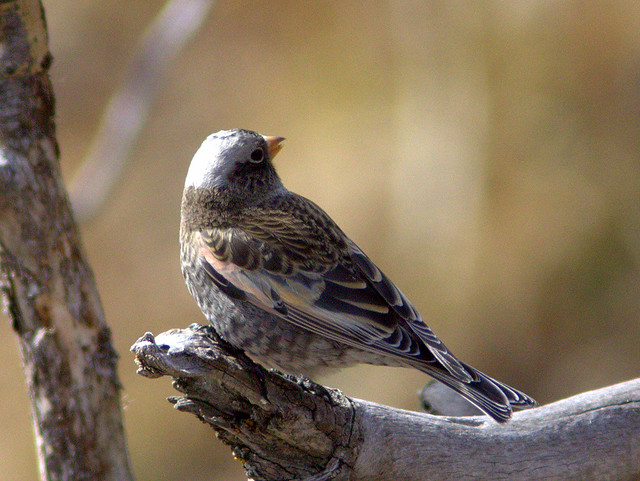
This bird that we first thought to be a Gray-crown was more brownish, but close examination of the photo reveals it to be an adult female Black Rosy-Finch. The angle of light caused reflection that made the bird look lighter than it really was.
An Abert’s Squirrel was dominating the feeder, and we had to chase it away repeatedly. The Rosies avoided the feeder when either the squirrel or a Steller’s Jay was present.
Mountain Chickadees shared the feeder…
…with Red-breasted Nuthatches…
…and the local Gray-headed race of the Dark-eyed Junco.
The next day, the forecast called for snow, but we ventured up Crest Road again. It started to rain as we checked for Pygmy Nuthatches at Doc Long Picnic Area near the base, and clouds enveloped the mountain. We turned back, deciding to bird around Albuquerque. We returned to the Crest on November 14, negotiating snow-packed areas on the road. Near the top, the moisture from the clouds had condensed to form a thick layer of hoarfrost on the trees.
Now there were flocks of up to 13 Black Rosy-Finches at the feeder. Here, two are perched on a frosty branch.
Before the banders introduced a degree of sophistication into our identification of the rosy-finches, we gave up on identifying many of the hatch-year birds, especially early in the season, as all have buffy brown tips on their contour feathers. At first we simply called them “Rosy-Finch sp.,” or “Buffies.” Now we know to take a closer look at the bases of the feathers. If they are black or very dark brown, and the bird has a whitish crown, it is a Black Rosy-Finch. Immature Gray-crowned Rosy-Finches have more cinnamon-brown feather bases. Male Blacks, even immature ones, show rather extensive pink on their underparts and wing coverts, while in females the color is very subdued. Even adult Gray-crowned Rosy-Finches show relatively little pink. This indeed is an immature (hatch year) female Black Rosy-Finch. Note the hint of pink on her shoulders and lower belly.
Our disappointment at not being able to positively identify any Gray-crowned Rosy-Finches was tempered by the appearance of the first Brown-capped Rosy-Finch of the season. Note its lack of a light crown and the more intense rosy undersides. A band from a previous season confirms that it is an adult.
Although the temperature had dropped to 22 degrees, the winds had died down, and photography conditions were much better than two days previously. Somehow, this beautiful adult black-Rosy-Finch had escaped the banding traps in previous years.
Though my fingers were about to freeze and drop off, I was able to get a nice shot of a Mountain Chickadee against a natural background…
..and a Red-breasted Nuthatch in a typical pose.
I shot this photo of a Steller’s Jay from inside the windows of the Crest House. Staff had spread the seed around to allow the finches to visit without being harassed by the jays.
Sandia Crest, just east of Albuquerque, New Mexico, is the most accessible site in the world where all three North American rosy-finch species can be seen at one time. We maintain the Sandia Crest Birding FORUM, where you will find interesting discussions on identification as well as updated sighting reports of not only the Rosies, but also such more unusual birds as Clark’s Nutcracker, Red Crossbill, Cassin’s Finch, Northern Pygmy-Owl and American Three-toed Woodpecker.
 Update on the Rosy-Finches of Sandia Crest, New Mexico. Flocks of all three species are expected to return in early November. Check out the links in rosyfinch.com for more information.
Update on the Rosy-Finches of Sandia Crest, New Mexico. Flocks of all three species are expected to return in early November. Check out the links in rosyfinch.com for more information.
Steve Cox of Rio Grande Bird Research takes measurements of a newly banded rosy-finch at Sandia Crest as Carol Davis keeps the records (Photo by Martin Selzer, Copyright 2004, used with permission:
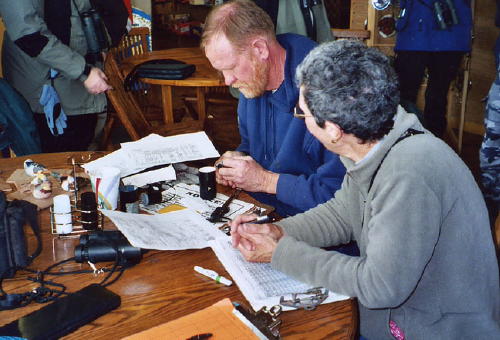
Readers of our rosyfinch.com Web suite know that the rosy-finch banding at Sandia Crest House is conducted by Rio Grande Bird Research, Inc. If you, as I, missed attending their Sandia Rosy-Finch Sponsorship Challenge “Meet the Banders” kick-off event in Albuquerque this past week, you still have the opportunity to contribute to an exciting new research project. A National Audubon Society grant award to Central New Mexico Audubon Society has already been supplemented by pledges from other major donors for the next phase of the project (notably, Rio Grande Bird Research, Eileen Beaulieu, Central New Mexico Audubon Society Chapter, Robert Munro, Gale Owings, and Wild Bird Center, owned by Lee Hopwood and Nikki Love). This phase is outlined in the grant proposal below.
Nancy and Steve Cox of Rio Grande Bird Research describe Sandia Crest as the premier location in the world to view all three species of Rosy-Finch. “It’s also the best and most important place on earth to research these birds in their winter habitat. That’s where the Rosy-Finch Banding Research Team comes in. Their work could uncover secrets of Rosy-Finch roosting habits and help bird lovers make sure these beautiful creatures are still around to delight our grandchildren.”
The late Ryan Beaulieu, close friend of Raymond, Michael and Cole, exhibits a Black Rosy-Finch to visiting birders from Delaware Valley Ornithological Club (Photo by Naomi Murphy, Copyright 2004, used with permission):
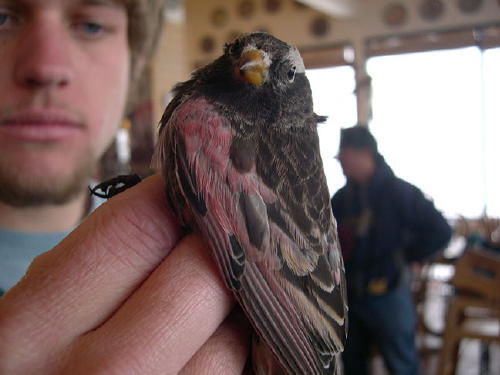
During the Sandia Rosy-Finch Sponsorship Challenge gathering, Raymond Vanbuskirk, Michael Hilchey and Cole Wolf, three young researchers, and master bird bander Steve Cox reviewed the past, present and future of the Rosy-Finch project, and welcomed any donation to the Rosy-Finch cause. “Larger donations deserve special thank you’s: Bring or send us $50 and earn special recognition on the Benefactor Wall, which travels with the team whenever it is bird banding or giving a presentation; bring $100 and you’ll get a certificate recognizing your contribution to our environment and the Rosy-Finch Project. This research is overseen by the master bird bander and experienced researchers of Rio Grande Bird Research Inc., a 501(c)(3) nonprofit organization, so all the money you donate is tax deductible to the extent allowed by law.”
Rio Grande Bird Research, Inc,
4426 San Isidro NW,
Albuquerque, NM 87107.
Central New Mexico Audubon Society’s (CNMAS)
Application For Collaborative Project Funding For FY2008
The three Rosy-finch species are some of North America’s most sought after and least understood birds. Sandia Crest is the most accessible place in the world where visitors can observe the three species together, while enjoying hot chocolate in the warmth of the crest house. Sandia Crest house has been known as the southern limit of these species’ range in the winter, but it is not known if the same individuals return year after year. To answer this question, a research project was needed.
In 2003 Ryan Beaulieu and Raymond VanBuskirk initiated the Rosy-finch Project under the auspices of Rio Grande Bird Research Inc. Other collaborative partners are CNMAS, Cibola National Forest Service, Wild Bird Centers of America, the owners and operators of the Sandia Crest House, and dozens of volunteers. Currently the project is headed up by Raymond VanBuskirk, Cole Wolf, and Michael Hilchey, local high school students. Raymond, Cole, and Michael are currently CNMAS board members.
For the past five winters under permit from US Geologic Service Banding Laboratory and the NM Department of Game and Fish, we have been capturing, banding, and taking many measurements of the birds, then safely releasing them, in hopes that they will return in following years. To date we have banded over 1,000 birds and recaptured 47 from previous years. We plan to continue the banding to better answer our original question; we also plan to expand the project by using radio telemetry to study where these birds are roosting at night, where they go when they are not at the crest house feeders, and their general flocking behavior. To conduct this research $ 5,500 will be needed to obtain the proper and safe equipment. The equipment includes radio transmitters and receivers, snowshoes, GPS, and two-way radios. We have obtained $2,000 in funding from other sources, and the money from this grant, in addition to other grants we are applying for, would bring us much closer to our goal.
We plan to attach radio transmitters to three birds of each species, for a total of nine transmitters. All precautions will be taken to ensure the safety of the birds. Using the snowshoes, GPS, and radios, two teams of three individuals each will maneuver the mountain slopes, while triangulating the birds with the use of the receivers. After we have found the roost sites we will take observations on behavior, temperature of roost site, habitat, etc.
Not only will the data from this research add to ornithological knowledge, but it will also help to educate the public about bird and habitat conservation. Over the past five years the project has attracted dozens of volunteers from around the state, hundreds of birders and Audubon members from all parts of the country, and visitors from as far away as Germany, New Zealand, England, Nicaragua, Ecuador and Australia. Another educational tool that has been utilized by 56,737 “virtual” visitors is the rosy-finch website at www.rosyfinch.com. We hope that these visitors to the Crest House, and the website leave with an experience that broadens their love for the natural world, and a commitment to the importance of saving it.

In a little over two months, the three Rosy-finch species will return for the winter to Sandia Crest, just east of Albuquerque, New Mexico. Start planning your trip, which might coincide with attending the 2008 Festival of the Cranes at Bosque del Apache NWR scheduled for November 18-23
The full daily schedule of 2008 Festival of the Cranes events (workshops, tours, hikes, exhibits and lectures, dinner, keynote address) may be found at the new Friends of the Bosque Web site. There will even be two tours of the Trinity Site, where the first atomic bomb was detonated.
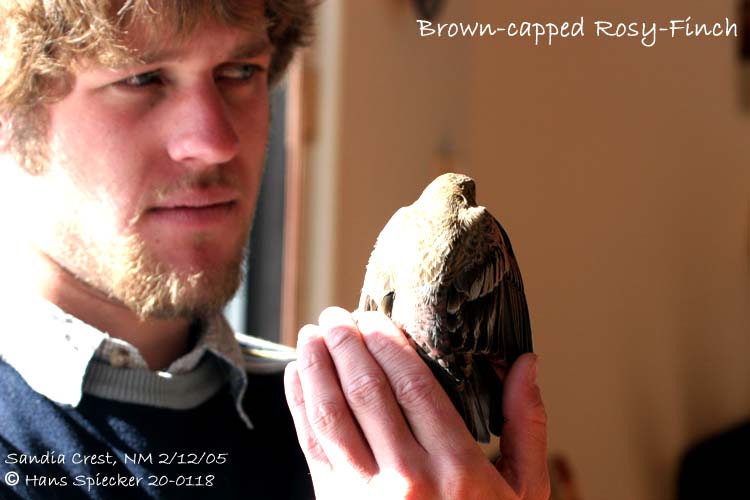
This week marks the third anniversary of the death of Ryan Beaulieu, the young New Mexico birder and rosy-finch researcher. His family and friends have established a scholarship in his honor, administered by the Central New Mexico Audubon Society.
For more information about the Ryan Beaulieu Memorial Youth Scholarship, visit this link.
Read about Ryan:
High Fives to an “Awesome” Birder
Ryan and the Winter of 2004-2005
Visit Ryan Beaulieu’s Memorial Page
Cole Wolf, another expert young bird researcher, artist, and one of Ryan’s close friends, was awarded the 2008 Ryan Beaulieu Memorial Youth scholarship.
Cole captured this dramatic photo of rosy-finches mobbing a Red-tailed Hawk at Sandia Crest (click on the photo for a full-screen wide view of the action):
The following is Cole’s report on his experience at the Maine Audubon Youth Birding Camp:
I was fortunate enough to be the recipient of the 2008 Ryan Beaulieu Memorial Youth Scholarship; I used the scholarship to attend Maine Audubon’s Youth Birding Camp on Hog Island, ME.
Hog Island is a private sanctuary owned by Maine Audubon located off the state’s southern coast. I spent five nights on the island with eleven other teens interested in birds and nature. On the morning bird walks around the island we heard dozens of Black-throated Green Warblers and Northern Parulas along with the occasional Blackburnian Warbler. White-throated Sparrows were also common. Common Loons, Black Guillemots, and groups of Common Eiders were often seen from shore. Unfortunately our group missed the Ruffed Grouse that wandered into camp one morning. On the final morning our leaders set up mist nets; we banded a Carolina Wren and several Purple Finches. Besides birds we also saw a Porcupine and several Garter Snakes on the island.
Although we stayed on Hog Island, during the day we usually went birding elsewhere. Several times we spent mornings on the mainland looking for warblers and other woodland birds. I saw fifteen species of wood-warblers during the camp, including Canada, Magnolia, Chestnut-sided, and Pine. Besides the many warblers we saw Red-shouldered Hawk, Yellow-bellied Sapsucker, Eastern Wood-Pewee, Blue-headed Vireo, and Baltimore Oriole. We also spent time in marshy habitats and had birds like Black Duck, Alder Flycatcher, Swamp Sparrow, and Bobolink. One of the most memorable experiences of the trip was having lunch overlooking a Bobolink colony. There were at least four pairs in the fields around us and the males sang and displayed almost constantly.
Of course we also visited Maine’s most famous birding locations: Eastern Egg Rock and Acadia National Park. Eastern Egg Rock is one of the sites where Atlantic Puffins have been reintroduced to Maine. Although it was a foggy day, we still managed to see dozens of Puffins and Guillemots. We also saw four species of terns: Common, Arctic, Roseate, and Black. Though Black Terns are common in New Mexico, the species is endangered in Maine and had never before been recorded at Eastern Egg Rock. On the trip back we got close-up looks at all three species of Scoters.
We spent a full day at Acadia National Park. Besides spectacular scenery, highlights included the only Northern Gannet of the trip, a family of Peregrine Falcons, several Least Flycatchers, and a singing Veery.
I would like to thank the Ryan Beaulieu Memorial Fund for paying to send me to Hog Island. I would also like to thank CNMAS’s Education and Scholarships committee for selecting me to receive the scholarship. It was a very memorable experience and I saw lots of great birds. I encourage you to donate to the Ryan Fund; it makes experiences like mine possible.
 The story of the Rosy-Finches of Sandia Crest, New Mexico. This flag waves all winter on rosyfinch.com, when rosy-finches are present at Sandia Crest. It stopped waving on April 4, when the last flocks were seen. A few finches visited after April 4th, but no appreciable flocks. One Black Rosy-Finch was coming in for seed on April 8. Feeders and sighting logs were removed April 9th. Now we can look forward to their return, next November! In the meantime, explore the links below and to the left, and know there is great birding in the Sandias and the greater Albuquerque area all year ’round.
The story of the Rosy-Finches of Sandia Crest, New Mexico. This flag waves all winter on rosyfinch.com, when rosy-finches are present at Sandia Crest. It stopped waving on April 4, when the last flocks were seen. A few finches visited after April 4th, but no appreciable flocks. One Black Rosy-Finch was coming in for seed on April 8. Feeders and sighting logs were removed April 9th. Now we can look forward to their return, next November! In the meantime, explore the links below and to the left, and know there is great birding in the Sandias and the greater Albuquerque area all year ’round.
(The rosy-finch flocks at Taos Ski Valley persisted until April 21, according to Gil Bachmann, Manager of the Kandahar Condominiums. A few individuals were still there on April 27. Gil said he missed the flurry of activity.)
View of the Sandia Crest House from the south. The large picture windows on three sides provide excellent viewing of the rosy-finch feeders. (Click on photo for full screen view).
Back on December 7, 1999, Mary Lou and I saw our first rosy-finch up there, in the parking lot of the Crest House at 10,678 feet. Then, they were considered “rare but regular” winter visitors to the Sandia Mountains. We had previously chased after them several times after seeing reports on the Internet, but had not succeeded in finding them until that snowy day. Since they had been attracted by bread crusts thrown away by some workers, we decided to return and scatter seed. It worked, and we kept putting out seed in the parking lot, and the birds have been visiting reliably every day of every winter since then. Usually, all three species and both the Interior and Hepburn’s (Gray-cheeked) race of the Gray-crowned Rosy-Finch have been there together.
Within two years we had engaged the US Forest Service, the Central New Mexico Audubon Society, and some private wild bird feeder and seed suppliers in a cooperative venture. Sunwest Silver, the Albuquerque company that owns Sandia Crest House, is the key to the success of the project, as they provided space for the feeders. The Forest Service prohibits feeding of wildlife on all but the “developed” or leased areas within its boundaries. (The Loveland ski resort in Colorado had its popular feeders removed a couple of years ago on order of the Forest Service. Frankly, their central location posed a traffic hazard as birders and skiers competed for parking spaces on the often slippery and snowy parking lot. Happily, Sandia Crest is far uphill from the “downhill” crowd, so there is usually plenty of parking.)
The first feeders at Sandia Crest were erected in February, 2001 and, as they say, “the rest is history.” You can read the whole story here in this article I wrote for Birders World. Much of the credit for the success goes to the USFS professionals and Volunteers, the Central New Mexico Audubon Society (the formal partner with the USFS in this project), notably to several young birders, merchants who continue to support the project, and the managers of the Crest House Restaurant and Gift Shop, which continues to host the feeders and accommodate the birding public along with regular customers. Organized research began largely in response to the efforts of the late Ryan Beaulieu, a High School student. His buddies have carried on the tradition (among them, Raymond VanBuskirk, Michael Hilchey and Cole Wolf, but I dare not try to name them all, for they are legion– just look at this page and this one as well!!).
Steve and Nancy Cox, of Rio Grande Bird Research, with the help of many volunteers, began a regular winter banding operation at Crest House in 2004. So far, they have banded over 1600 rosy-finches and are also conducting isotope studies to try to unravel the life histories of the four races of rosy-finches that converge on Sandia Crest every winter. Dave Weaver and Fran Lusso, trained USFS Volunteers, took over our duties as coordinators of the rosy-finch feeding project when we moved to Florida in 2004, and have served ably and with great dedication. They did not consider themselves “birders” when they started, but they quickly learned to separate the rosy-finch species, and now they are experts at identifying most anything that flies.
| May through October, TUESDAY MORNING GUIDED BIRD WALKS in the Sandia Mountains, sponsored by the U.S. Forest Service and Central New Mexico Birders meet at 8:00 a.m. (8:30 in May and October) at the |
 Update on the Rosy-Finches of Sandia Crest, New Mexico. The flag is waving– Rosy-Finches are now visiting the feeders at Sandia Crest House.
Update on the Rosy-Finches of Sandia Crest, New Mexico. The flag is waving– Rosy-Finches are now visiting the feeders at Sandia Crest House.
We time-shifted with our DVR and watched last week’s PBS Nature special on the Red Knots and the Horseshoe Crabs of Delaware Bay. There is a striking parallel between the Red Knots and the rosy-finches, as both species exist on the edge of survival. While the knots are in a more precarious situation, both spend relatively little time on their arctic and alpine breeding grounds, and both face formidable hazards during migration and on their wintering grounds. Both may be adversely affected by climate change. If you missed it, you can view a narrative and film clip here.
The banders had a good day on February 17, with repeated waves of rosy-finches spaced about an hour apart. They newly banded 28 birds (22 Brown-capped, 2 Blacks, and 4 Gray-crowned - all interior race). That brings the season total of newly banded birds to 408 birds (253 Brown-capped, 70 Blacks, and 85 Gray-crowned - 25 Hepburn’s). The total for all seasons is 1605 birds (355 Brown-capped, 927 Blacks, and 323 Gray-crowned.) They had had 64 recaptures (46 Brown-capped, 3 Blacks, and 15 Gray-crowned (12 interiors and 3 Hepburn’s). Of these recaptures, there were 3 that were from the 2006/2007 season. Two of them were Blacks and one was a Gray-crowned Interior. So far this winter, they have now seen 36 birds from previous seasons. The road was clear.
Last Sunday February 10, the day started slowly, but the team ended up newly banding 32 rosy-finches and recapturing an additional 21, all from this season. Brown-capped Rosy-Finches continue to predominate, as they have since early December, with today’s total being 27. For the first time, there were no Hepburns subspecies among the 4 Gray-crowned rosies newly banded.
The previous Sunday, February 10, the day started slowly, but the team ended up newly banding 32 rosy-finches and recapturing an additional 21, all from this season. Brown-capped Rosy-Finches continue to predominate, as they have since early December, with today’s total being 27. For the first time, there were no Hepburns subspecies among the 4 Gray-crowned rosies newly banded.
Banding was limited on February 3 due to 50 mph winds and blowing snow, yet the researchers trapped 36 rosy-finches, 25 of which were recaptures. See my Blog entry about the recaptured Brown-capped Rosy-Finch that was banded back in the winter of 2004-05, the late Ryan Beaulieu’s last year of banding. The prior week, Nancy Cox described the January 27 banding session in glowing terms. See Nancy and Steve Cox’s full reports on the Correspondence page.
Updated table and link to spreadsheet of all banding results
Banding and sighting reports: CORRESPONDENCE page
ID Tips: the four rosy-finch races at Sandia Crest
While Sandia Crest may be the best-known and most accessible “3 1/2 species” rosy-finch viewing location in the world, it is not the only one. In New Mexico, the Kandahar Condominiums at Taos Ski Valley offer guests, and a limited number of visitors, excellent viewing of large flocks. The new General Manager of the Kandahar Condos, Gil Bachmann, is a newly transplanted birder from Missouri. He is interested in sharing his birding experience by means of this Web space, and in finding ways to accomodate birders while minimizing disruption of his guest services. Birders saw over 200 rosy-finches there this week. Welcome to New Mexico, Gil!
Do read Derek Lovitch’s Blog with some beautiful photographs illustrating his Wings tour of New Mexico last week, highlighted by sightings of two very rare vagrants, the Barnacle Goose and the Rufous-backed Robin. Commenting on his visit to the Sandia Crest House, he writes: “Sure the view is nice . . . but the real reason for this trek to 10,678 was the Sandia Crest House, which, in addition to selling food and souvenirs, hosts some very famous feeders that host all three species of Rosy-Finch! Black, and Brown-capped (both lifers for me), and Gray-crowned (this year, also including at least two of the more coastal “Hepburn’s” subspecies)! This is THE location in North America for seeing Rosy-finches. While some visits are more productive than others, and sometimes one species or another is hard to find, this visit produced all three and a half subspecies in a feathered blizzard only a few minutes after we arrived.”
Unlike the last couple of years, the Brown-capped species is quite abundant, representing over half of the captures. The Hepburn’s (Coastal or Gray-headed) race, while not as abundant as last winter, are also quite numerous. Banding at the Crest House takes place most, but not all, Sunday mornings. Note that banding now begins at 9:30, when the Crest House normally opens to the public.
The rosies arrived on October 31st, 2007, the earliest arrival date for rosy-finches since we began keeping records in 1999. All three species are now present, with individual flocks of up to 100 birds! Fran Lusso and Dave Weaver put the feeders up on October 31 and had a Gray-crowned Rosy-finch feeding within 5 minutes. The first recorded flock of rosy-finches, numbering about 25, was seen on the afternoon of November 3.
The golf course camera has been updating irregularly. Even though snow may be melting down at the golf course, there may be frequent snow squalls up at the Crest. The parking lots are being kept clear at Crest House, the ski area, and the Snow Play area. The lower road down to the Capulin Spring “bird log” is closed. No reports yet of Northern Pygmy-owl sightings, either at the entrance to the Snow Play or the base of the ski area. Is anyone looking for them?














